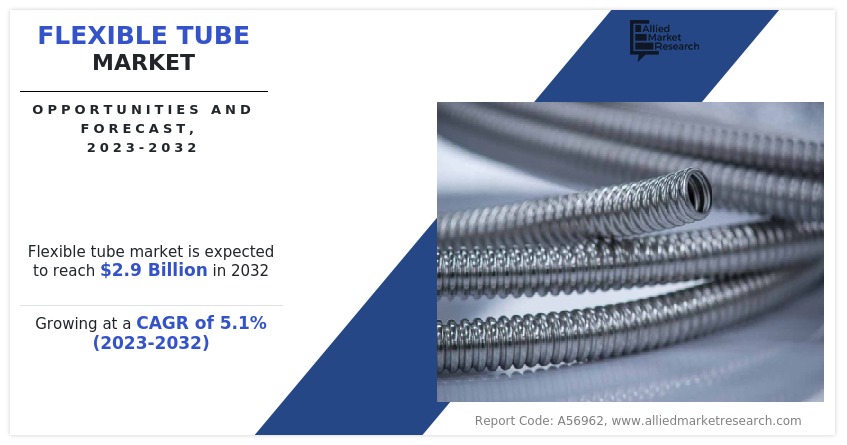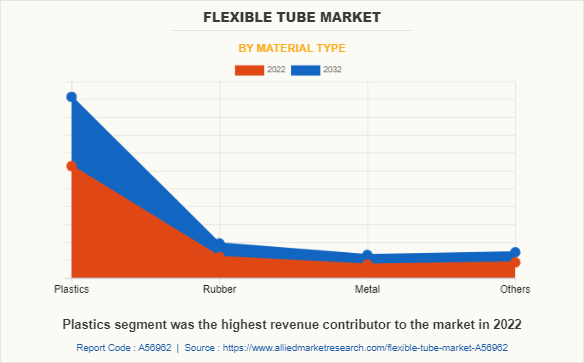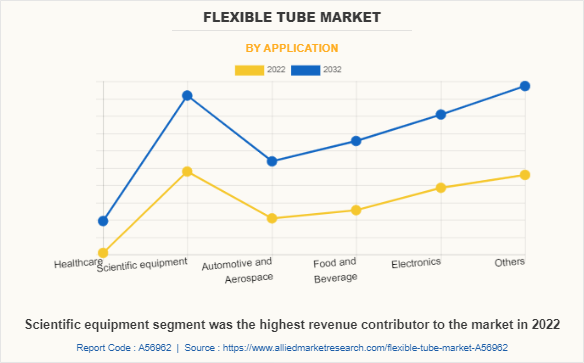Flexible Tube Market Research, 2032
The global flexible tube market size was valued at $1.8 billion in 2022, and is projected to reach $2.9 billion by 2032, growing at a CAGR of 5.1% from 2023 to 2032.
Report Key Highlighters:
- The flexible tube market is highly fragmented, with several players including Avantor, Inc., Cole-Parmer Instrument Company, LLC., Flex Tubes, NewAge Industries, Nordson Corporation, PARKER HANNIFIN CORP, Saint-Gobain, Spirax-Sarco Engineering plc company, Swagelok Company, and Teknor Apex.
- More than 4,500 product literatures, industry releases, annual reports, and other such documents of major industry participants along with authentic industry journals, trade associations' releases, and government websites have been reviewed for generating high-value industry insights.
- The study covers nearly 20 countries. The segment analysis of each country in terms of value and volume during the forecast period 2022-2032 is covered in the flexible tube market report.

A flexible tube is a type of tubing that is made to be bendable and flexible, allowing it to be used in various applications where rigid tubing is not suitable. Flexible tubes are primarily made from a wide range of materials, such as rubber, Polyvinyl Chloride (PVC), silicone, polyurethane, and others.
Growing demand from automotive & aerospace, electronics, food & beverage, plumbing, and industrial industries is expected to drive the flexible tube market growth.
Flexible tubes are used in numerous industries such as automotive & aerospace, electronics, food & beverage, and plumbing. They are widely used for fluid and gas transfer and for protecting and routing wires and cables. They come in various sizes, shapes, and configurations such as coiled, straight, and corrugated. They can be reinforced with a wide range of materials such as wire or fiber in order to offer additional durability and strength.
In addition, there is a surge in demand for flexible tubes produced from materials such as PVC, silicone, and polyurethane in the healthcare industry owing to their flexibility, biocompatibility, and ability to transport fluids and materials. These tubes are widely used for minimally invasive procedures that require smaller incisions and less invasive techniques as well as in medical devices including IV lines, catheters, and endoscopes.
Flexible tubes are employed in various oxygen delivery systems, such as oxygen masks or nasal cannulas. These tubes carry oxygen from a supply source to the patient's respiratory system, providing supplemental oxygen when needed. The flexibility of the tubes allows comfortable positioning and movement.
Furthermore, flexible tubes are employed in suction devices in order to release fluids or secretions from a patient's body during postoperative care, surgery, or other medical procedures. These tubes are attached to suction pumps and can be inserted into wounds, body cavities, or other areas to remove excess fluids or debris.
Moreover, Intravenous (IV) tubing consists of flexible tubes that medications, deliver fluids, or nutrition directly into a patient's bloodstream. These tubes are connected to IV bags or infusion pumps and allow controlled & accurate delivery of fluids or medications. However, flexible tubes are utilized in drainage systems for removing fluids or air from body cavities or wounds. For example, chest drainage tubes are used to drain fluid or air from the pleural cavity after thoracic surgeries or in cases of pneumothorax.
Furthermore, the surge in demand for flexible tubes from automotive industry has bolstered the market growth. Flexible tubes are used in automotive applications for fluid transfer, such as carrying fuel, coolant, or brake fluid. They deliver flexibility and durability, accommodating the movement of engine components. Flexible tubes, usually produced from materials such as rubber or high-pressure-rated synthetic materials, are utilized for transporting fuel from the fuel tank to the engine. These tubes are made to withstand the vibrations and pressure associated with fuel delivery.
Besides, flexible brake lines, also known as brake hoses, are crucial for transmitting hydraulic pressure from the brake pedal to the brake calipers or wheel cylinders. These tubes are typically made of rubber or reinforced with braided metal for strength and flexibility. Moreover, flexible tubes are used to transport engine coolant throughout the vehicle's cooling system. These hoses are designed to withstand high temperatures and coolant pressures, ensuring efficient cooling of the engine.
However, there are several disadvantages to using flexible tubes, such as the risk of material weakening and failure due to repeated bending and flexing. The use of multiple components can complicate troubleshooting and repair, and maintenance can be difficult due to wear and tear being more difficult to detect than in rigid pipes. Flexible tubes also have a limited ability to withstand high pressures, which can cause system downtime, damage, and safety hazards. These factors may lead to consumers preferring alternatives to flexible tubes, which can hinder‐¯market growth.
Nevertheless, the increase in demand for flexible tubes made from bio-based materials makes them sustainable alternatives to traditional petroleum-based materials. Bio-based tubes reduce environmental impact, are disposed of in an eco-friendly manner, and reduce waste and pollution. The demand for eco-friendly solutions, regulatory compliance, consumer demand, and advancements in materials science and manufacturing techniques drive the opportunity for bio-based flexible tubing. Advancements in bio-based materials science have led to new types of flexible tubing with unique properties, creating new growth opportunities for the industry.
The flexible tube market is segmented on the basis of material type, application, and region. By material type, the market is classified into plastic, rubber, metal, and others. By application, the market is categorized into healthcare, scientific equipment, automotive & aerospace, food & beverage, electronics, and others. By region, the flexible tube market share is analyzed across North America, Europe, Asia-Pacific, and LAMEA.
Key players in the flexible tube industry include Avantor, Inc., Cole-Parmer Instrument Company, LLC., Flex Tubes, NewAge Industries, Nordson Corporation, PARKER HANNIFIN CORP, Saint-Gobain, Spirax-Sarco Engineering plc company, Swagelok Company, and Teknor Apex.

Asia-Pacific dominated the market in 2022. Asia-Pacific is experiencing significant urbanization with growing population and an increase in demand for housing, transportation, and infrastructure. As per the Asian Development Bank (ADB), Asian cities are growing rapidly, and another 1.1 billion people are anticipated to live in the cities in the next 20 years. This is expected to propel the demand for flexible tubes in building and construction applications such as electrical wiring, plumbing, heating, ventilation and air-conditioning (HVAC) systems.
Moreover, the region is a prominent producer of automobiles with countries including Japan, China, and South Korea being major players in the automotive market across the globe. This is driving demand for flexible tubes in automotive applications such as fluid transfer, ventilation, and wiring protection. Besides, the region is also experiencing notable industrialization, with rising demand for industrial equipment and machinery. Flexible tubes are utilized in various industrial applications, such as conveying materials and protecting wires and cables, thereby bolstering the demand for these products in the region.

Plastics segment was the highest revenue contributor to the market in 2022. Consumers and businesses are becoming more aware of the negative impact that plastic waste can have on the environment and are looking for alternative solutions as demand for sustainable and eco-friendly materials rises. As a result, there is a growing trend toward the use of recycled or biodegradable materials in the manufacture of plastic flexible tubes.
Moreover, in recent years there has been a rise in demand for customization and personalization. Many businesses are seeking to differentiate themselves from competitors by offering unique packaging or branding, which includes custom-designed plastic flexible tubes in a variety of colors, shapes, and sizes. In addition, the use of plastic flexible tubes in the pharmaceutical and medical industries is expected to grow as new technologies and materials are developed to improve the safety and effectiveness of these products.

Scientific equipment segment was the highest revenue contributor to the market in 2022. Flexible tubes are used in automated liquid handling systems, such as pipetting robots, to transport liquids between different containers. They provide a flexible and precise method for transferring precise volumes of liquids.
Further, in gas chromatography, flexible tubes are used to transport carrier gases, such as nitrogen or helium, from the gas supply to the chromatography column. They ensure a consistent flow of gases and enable the separation and analysis of chemical compounds.
Moreover, flexible tubes play a crucial role in creating and maintaining vacuum conditions in scientific equipment. They are used to connect vacuum pumps to chambers, sample holders, or other components that require a controlled vacuum environment. In addition to that, flexible tubes are used in mass spectrometers, microscopes, cell culture systems, microfluidics, and elemental analysis.
The biotechnology and pharmaceutical industries are major users of scientific equipment, and this is driving demand for flexible tubes. According to the Biotechnology Innovation Organization (BIO) industry analysis reports, the amount of venture capital (VC) raised for both pain and addiction companies in the U.S. in 2021 was $228 million, representing only 1.3% of total therapeutic VC funding in the U.S. In the same year, oncology companies raised $9.7 billion, or 38.3% of total therapeutic VC funding in the U.S. Manufacturers are developing tubes that meet the specific needs of these industries, such as tubes that are suitable for use in cleanrooms or that can be sterilized.
Key Benefits For Stakeholders
- This report provides a quantitative analysis of the market segments, current trends, estimations, and dynamics of the flexible tube market analysis from 2022 to 2032 to identify the prevailing flexible tube market opportunities.
- The market research is offered along with information related to key drivers, restraints, and opportunities.
- Porter's five forces analysis highlights the potency of buyers and suppliers to enable stakeholders make profit-oriented business decisions and strengthen their supplier-buyer network.
- In-depth analysis of the flexible tube market segmentation assists to determine the prevailing market opportunities.
- Major countries in each region are mapped according to their revenue contribution to the global market.
- Market player positioning facilitates benchmarking and provides a clear understanding of the present position of the market players.
- The report includes the analysis of the regional as well as global flexible tube market trends, key players, market segments, application areas, and market growth strategies.
Flexible Tube Market Report Highlights
| Aspects | Details |
| Market Size By 2032 | USD 2.9 billion |
| Growth Rate | CAGR of 5.1% |
| Forecast period | 2022 - 2032 |
| Report Pages | 300 |
| By Material Type |
|
| By Application |
|
| By Region |
|
| Key Market Players | Spirax-Sarco Engineering plc, Cole-Parmer Instrument Company, LLC, Parker Hannifin Corporation, Swagelok Company, Saint-Gobain, NewAge Industries, Inc., Nordson Corporation, Flex Tubes, Teknor Apex Company., Avantor, Inc. |
Analyst Review
According to the opinions of various CXOs of leading companies, the flexible tube market is expected to witness increased demand during the forecast period. The demand for flexible tube is expected to grow during the forecast period as the use of automation and robots continues to expand across various industries, including manufacturing, logistics, and healthcare.
Moreover, growing demand for flexible tubes in the healthcare sector and surge in use of flexible tubes in automation and robotics are propelling the market. Flexible tubes allow smooth movement and maneuverability of robotic systems. They can be easily routed around complex configurations, tight spaces, and obstacles, enabling robots to reach difficult-to-access areas. Moreover, flexible tubes provide a practical solution for managing cables, wires, and hoses in automated systems. These factors indicate that the flexible tube market is expected to expand considerably during the forecast period.
The global flexible tube market was valued at $1.8 billion in 2022, and is projected to reach $2.9 billion by 2032, growing at a CAGR of 5.1% from 2023 to 2032.
Asia-Pacific is the largest regional market for Flexible Tube.
The key players operating in the flexible tube market include Avantor, Inc., Cole-Parmer Instrument Company, LLC., Flex Tubes, NewAge Industries, Nordson Corporation, PARKER HANNIFIN CORP, Saint-Gobain, Spirax-Sarco Engineering plc company, Swagelok Company, and Teknor Apex.
Rise in demand for flexible tubes in the healthcare industry coupled with an increase in the adoption of flexible tubes in automation and robotics are the key drivers of the Flexible Tube Market in the world.
Scientific equipment is the leading application of Flexible Tube Market.
Loading Table Of Content...
Loading Research Methodology...



